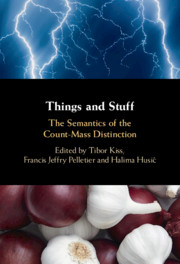Book contents
- Things and Stuff
- Things and Stuff
- Copyright page
- Dedication
- Contents
- Figures
- Tables
- Contributors and their Affiliations
- Preface
- 1 Editorial Introduction: Background to the Count–Mass Distinction
- Large-Scale Architectures for Count and Mass
- Implications from Individual Languages
- Compositional Analyses and Theoretical Issues
- New Empirical Approaches to the Semantics of the Count–Mass Distinction
- 14 The Role of Context and Cognition in Countability: A Psycholinguistic Account of Lexical Distributions
- 15 Plurality Without (Full) Countability: On Mass-Like Categories in Lexical Plurals
- 16 Determining Countability Classes
- 17 Polysemy and the Count–Mass Distinction: What Can We Derive from a Lexicon of Count and Mass Senses?
- References
- Language Index
- Subject Index
14 - The Role of Context and Cognition in Countability: A Psycholinguistic Account of Lexical Distributions
from New Empirical Approaches to the Semantics of the Count–Mass Distinction
Published online by Cambridge University Press: 21 May 2021
- Things and Stuff
- Things and Stuff
- Copyright page
- Dedication
- Contents
- Figures
- Tables
- Contributors and their Affiliations
- Preface
- 1 Editorial Introduction: Background to the Count–Mass Distinction
- Large-Scale Architectures for Count and Mass
- Implications from Individual Languages
- Compositional Analyses and Theoretical Issues
- New Empirical Approaches to the Semantics of the Count–Mass Distinction
- 14 The Role of Context and Cognition in Countability: A Psycholinguistic Account of Lexical Distributions
- 15 Plurality Without (Full) Countability: On Mass-Like Categories in Lexical Plurals
- 16 Determining Countability Classes
- 17 Polysemy and the Count–Mass Distinction: What Can We Derive from a Lexicon of Count and Mass Senses?
- References
- Language Index
- Subject Index
Summary
Linguistic theory has provided different formalizations regarding the issue of countability, but it has hardly ever measured the occurrence of nouns as mass and as count in language use. This work illustrates a rating study on subjective frequency of Italian nouns inflected in the singular and in the plural. The rating scores were compared to the corpus frequency of nouns in mass and count contexts. The results suggest that in Italian almost every noun can occur as countable. Moreover, negative correlations were never found between the count use and the mass use of nouns. These results are discussed with respect to the different theoretical accounts.
Keywords
Information
- Type
- Chapter
- Information
- Things and StuffThe Semantics of the Count-Mass Distinction, pp. 321 - 336Publisher: Cambridge University PressPrint publication year: 2021
Accessibility standard: Unknown
Why this information is here
This section outlines the accessibility features of this content - including support for screen readers, full keyboard navigation and high-contrast display options. This may not be relevant for you.Accessibility Information
- 4
- Cited by
